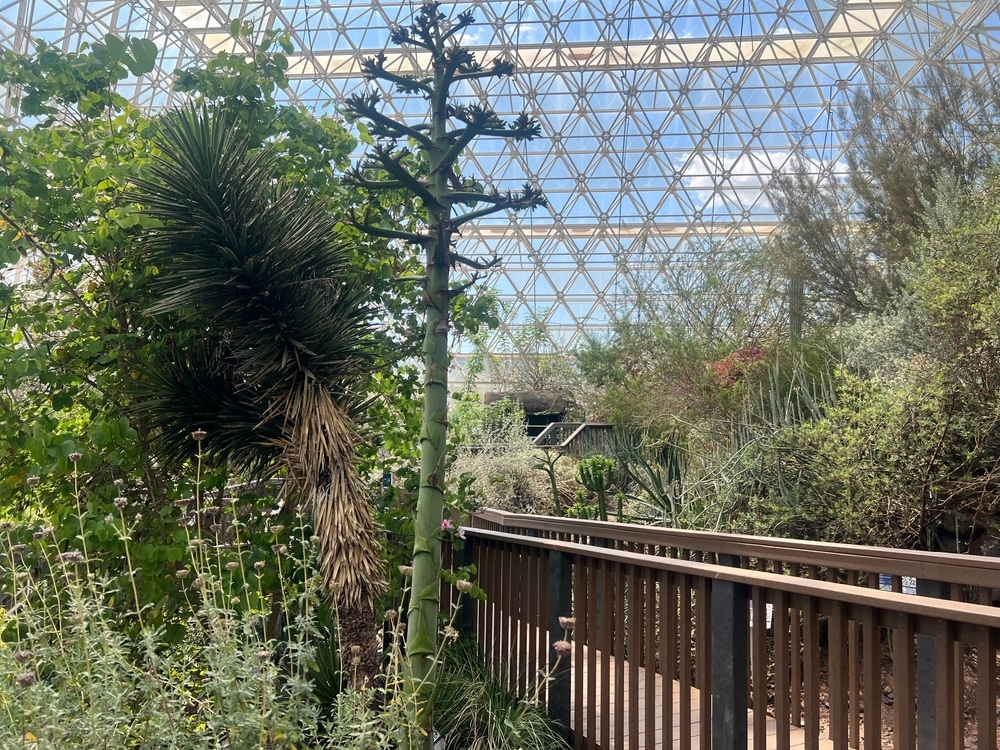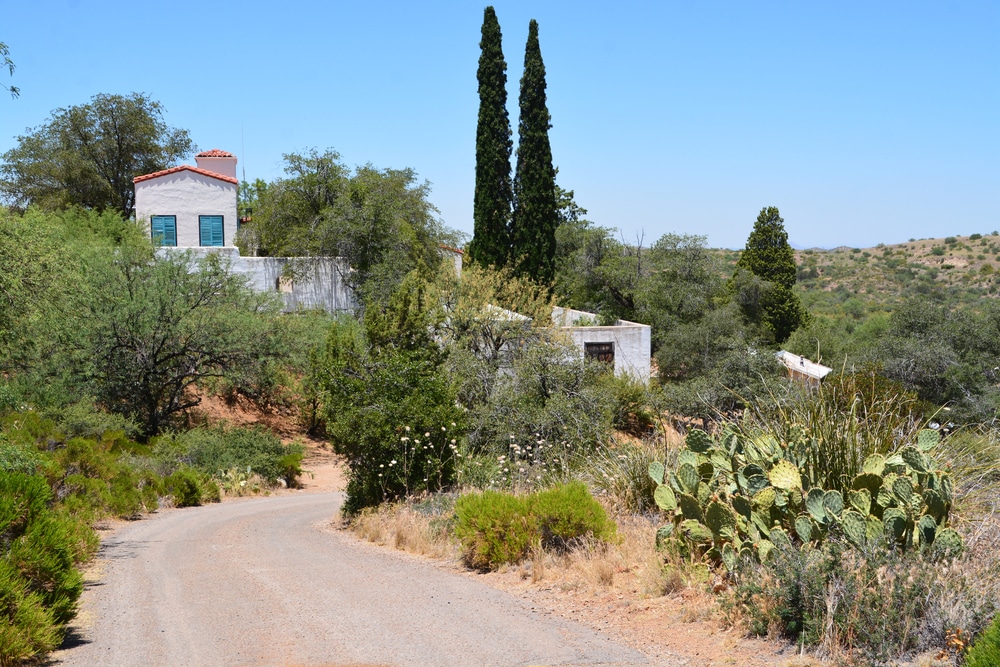Oracle State Park, a 4,000-acre wildlife refuge and environmental education center, stands as a testament to Arizona’s commitment to preserving its natural heritage while providing exceptional recreational opportunities for visitors. Located in the northern foothills of the Santa Catalina Mountains at an elevation of approximately 4,500 feet, the park occupies a unique ecological transition zone between the Sonoran and Chihuahuan deserts.
Originally part of the historic Kannally Ranch, this land has witnessed generations of human history, from indigenous peoples who first inhabited the region to the cattle ranching era of the early 20th century. The centerpiece of the park is the Mediterranean-Revival style Kannally Ranch House, built between 1929 and 1932, which now serves as a museum and visitor center, offering a glimpse into the area’s ranching past.
The park is situated near the small town of Oracle, approximately 40 miles north of Tucson (GPS coordinates: 32.6086° N, 110.7706° W). Its location makes it easily accessible for day trips from Tucson, Phoenix, and surrounding communities, yet it remains one of Arizona’s more peaceful state parks, offering a respite from the busier tourist destinations

What distinguishes Oracle State Park within Arizona’s park system is its dual designation as both a state park and an International Dark Sky Park—one of the first state parks in Arizona to receive this prestigious recognition. This designation highlights the exceptional quality of the night skies above the park, largely unaffected by light pollution from urban centers.
Visitors to Oracle State Park can explore diverse ecosystems through an extensive network of hiking trails, marvel at the historic Kannally Ranch House, participate in environmental education programs, or simply enjoy the tranquility of this natural sanctuary. The park’s location in a transition zone between desert and woodland environments creates a biodiversity hotspot, with vegetation ranging from desert grasslands to oak woodlands and wildlife that includes over 100 species of birds, numerous mammals, and various reptiles.
Unlike many Arizona state parks centered around water features, Oracle State Park showcases the beauty of the state’s upland environments, inviting visitors to connect with the land in its more pristine form. Whether you’re a history enthusiast, nature lover, educational group, or stargazer, Oracle State Park offers a unique slice of Arizona’s natural and cultural heritage.

The centerpiece of Oracle State Park is the stunning four-level Kannally Ranch House, built in Mediterranean Revival style between 1929-1932. Docent-led tours showcase the home’s distinctive architecture, original furnishings, and the Kannally family’s history as wealthy tuberculosis patients who moved west for the healing climate. The house features hand-painted ceiling beams, unique built-in furniture, and period artwork including Lucille Kannally’s paintings. The ranch house patio offers one of the most scenic viewpoints in the entire park.
Designated as an International Dark Sky Park, Oracle offers exceptional stargazing opportunities with minimal light pollution. The park occasionally hosts evening astronomical programs with telescopes and guided constellation tours. The clear, dry air and higher elevation create ideal conditions for observing celestial objects, from familiar constellations to distant galaxies normally obscured by urban lighting. The park sometimes offers special night-access permits for serious amateur astronomers.

The diverse landscapes within Oracle State Park create exceptional photography opportunities throughout the seasons. Spring wildflower blooms, summer monsoon clouds, fall color changes in oak woodlands, and winter light on distant mountain ranges provide compelling subjects year-round. The historic ranch house with its Mediterranean styling offers architectural interest, while the expansive grassland vistas showcase Arizona’s lesser-known landscapes beyond typical desert imagery.

Oracle State Park offers over 15 miles of scenic trails traversing diverse landscapes from oak woodlands to desert grasslands. The Granite Overlook Trail provides spectacular panoramic views of the San Pedro Valley and distant mountain ranges, while the Nature Trail offers a gentler interpretive experience focusing on local ecology. The Arizona Trail passes through the park, connecting hikers to this 800-mile route spanning the entire state from Mexico to Utah. These well-maintained paths accommodate all skill levels and showcase the unique transition zone between desert and mountain ecosystems.

The park’s location in a biological transition zone creates habitat for diverse wildlife species. Visitors commonly observe mule deer, javelina, coyotes, and abundant bird species including acorn woodpeckers, western bluebirds, and various raptors. The American Avenue wildlife viewing area features educational displays about local fauna and comfortable seating for patient observation. Dawn and dusk provide the best opportunities for wildlife encounters when animals are most active.

Several designated picnic areas throughout the park offer tables, shade structures, and scenic views. The Kannally Ranch House patio features picnic facilities with spectacular valley vistas, while more secluded tables along upper trails provide peaceful settings among oak groves. These facilities create perfect settings for outdoor meals before or after exploring the park’s other attractions.

| Detail | Information |
|---|---|
| Location | Oracle, Arizona (north of Tucson) |
| Established | 1988 |
| Size | 4,000 acres |
| Designation | Center for Environmental Education |
| Former Use | Cattle ranch owned by the Kannally family |
| Main Feature | Historic Kannally Ranch House (Mediterranean-style) |
| Built | 1929-1932 |
| Elevation | Approximately 4,500 feet |
| Landscape | Oak grassland with desert transition zone |
| Wildlife | Deer, javelina, coyotes, bobcats, over 100 bird species |
| Trails | 15 miles of hiking, equestrian, and mountain biking trails |
| Notable Trails | Granite Overlook Trail, Wildlife Corridor Trail, Arizona Trail access |
| Dark Sky Status | International Dark Sky Park (designated in 2014) |
| Activities | Hiking, wildlife viewing, stargazing, picnicking, educational programs |
| Ranch House | Four-level adobe structure with museum exhibits and art gallery |
| Hours | Seasonal, typically open weekends |
| Special Programs | Nature walks, astronomy nights, environmental education |
| Connection | Arizona Trail passes through the park |
Oracle State Park encompasses a remarkable transition zone where lower desert ecosystems gradually blend into higher elevation woodlands. This 4,000-acre expanse stretches across elevations ranging from approximately 3,700 to 4,600 feet, creating microhabitats that support diverse plant and animal communities.
Unlike many of Arizona’s state parks that feature lakes or rivers as central attractions, Oracle State Park’s natural treasures lie in its rolling hills, grassy valleys, and oak-studded slopes. The park’s topography offers expansive views of the surrounding landscapes, including the dramatic Santa Catalina Mountains to the south, the Galiuro Mountains to the east, and on clear days, visitors can see as far as the distant Tortolita and Picacho mountains.
The bedrock underlying Oracle State Park consists primarily of granitic formations dating back to the Precambrian era, some of the oldest rock formations in Arizona at approximately 1.4 billion years old. Over millennia, erosion processes have shaped the granite into the gently rolling terrain visible today. In certain areas of the park, distinctive granite outcroppings punctuate the landscape, creating natural overlooks and habitat niches.
The park’s soil composition varies considerably, from sandy decomposed granite to clay-rich areas that support different vegetation communities. This soil diversity contributes significantly to the ecological variety found throughout the park.
Oracle State Park sits within the watershed of the San Pedro River, one of the last free-flowing rivers in the Southwest. While there are no permanent streams within the park boundaries, several drainages and washes channel seasonal rainfall toward the San Pedro River basin. After significant rain events, especially during the summer monsoon season, ephemeral streams and pools may appear briefly throughout the park’s lower elevations.
Water conservation and watershed protection are important aspects of the park’s management philosophy. Natural water catchments throughout the property provide critical resources for wildlife, especially during Arizona’s drier months. Park officials work to maintain healthy watershed conditions by managing erosion, protecting natural drainages, and implementing sustainable water practices at park facilities.
The park’s position in this transition zone allows visitors to observe how slight changes in elevation, aspect (the direction a slope faces), and soil composition can dramatically influence which plant communities thrive in different areas. This natural laboratory demonstrates ecological principles in action, making Oracle State Park not just a recreational destination, but also an invaluable outdoor classroom for understanding Arizona’s diverse environments.
As seasons change, so does the park’s appearance. Winter may bring occasional snow dustings to the higher elevations, spring transforms hillsides with wildflower displays, summer monsoons rejuvenate the landscape with vibrant green growth, and autumn paints the oak woodlands with subtle color changes—each season offering visitors a different perspective on this remarkable landscape.
Oracle State Park’s position at the convergence of multiple ecosystems creates a biological diversity that surpasses what visitors might expect in a park of its size. The park’s vegetation reflects its transitional nature, with plant communities characteristic of both higher and lower elevations intermixing across the landscape.
The lower elevations and south-facing slopes support classic Sonoran Desert and semi-desert grassland species. Here, visitors will find various cacti including prickly pear, cholla, and occasional barrel cacti, alongside desert shrubs such as creosote bush, catclaw acacia, and mesquite. As one moves to higher elevations and north-facing slopes, the vegetation transitions to oak woodland communities dominated by Emory oak, Mexican blue oak, and Arizona white oak. These majestic trees, some centuries old, create dappled shade habitats that support entirely different understory plant communities.
Throughout the park, depending on the season, wildflower enthusiasts can discover numerous native species including Mexican goldpoppy, lupine, globemallow, penstemons, and various sunflowers. Spring (March-May) and the summer monsoon season (July-September) offer the most spectacular floral displays, though the park maintains botanical interest year-round.
The diverse plant communities of Oracle State Park provide habitat for an equally impressive array of wildlife. Mammals commonly spotted include white-tailed deer, javelina, coyotes, bobcats, gray foxes, and numerous rodent species such as rock squirrels and Harris’s antelope squirrels. Though rarely seen, mountain lions occasionally pass through the park’s more remote sections.
Bird enthusiasts find Oracle State Park particularly rewarding, with over 100 species documented within its boundaries. Year-round residents include Gambel’s quail, cactus wrens, curve-billed thrashers, and various woodpeckers including Gila and acorn woodpeckers. The oak woodlands attract species like Mexican jays, bridled titmice, and painted redstarts. During migration seasons, the park welcomes numerous additional species passing through, making spring and fall especially productive for birdwatching.
The park’s reptile population includes western diamondback rattlesnakes, gopher snakes, desert spiny lizards, and greater earless lizards. Visitors hiking in warmer months should maintain appropriate caution regarding rattlesnakes, though encounters are relatively uncommon.
Several species of conservation concern make their home in Oracle State Park. These include the Arizona gray squirrel, lowland leopard frog, and various bat species that utilize the park’s habitats. The park’s protection of native grasslands also provides increasingly rare habitat for grassland bird species facing habitat loss throughout the Southwest.
Seasonal ecological changes dramatically alter the park’s appearance and wildlife activity patterns:
For the best wildlife viewing, visitors should plan early morning or late afternoon outings when animals are most active. The Granite Overlook Trail and Wildlife Corridor Trail are particularly productive for wildlife observation, though patient observers may encounter interesting species on any of the park’s trails.
Oracle State Park offers diverse recreational opportunities focused on connecting with nature while preserving the park’s tranquil atmosphere and ecological integrity. Unlike parks centered around water features, Oracle specializes in land-based activities that showcase its unique natural and cultural resources.
Hiking stands as the premier activity at Oracle State Park, with over 15 miles of trails traversing diverse terrain and ecosystems. The trail system accommodates hikers of all abilities, from casual walkers to experienced trekkers:
More ambitious hikers can access the Arizona National Scenic Trail, which passes through the park on its 800-mile route spanning Arizona from Mexico to Utah.
While Oracle State Park lacks water features for swimming or boating, its outdoor experiences focus on connecting with the landscape in more contemplative ways. Picnicking opportunities abound, with ramadas available near the ranch house and at various points along the trails. These designated picnic areas, some equipped with tables and grills, provide perfect settings for meals amid natural beauty.
The park has become a premier destination for photography enthusiasts. The historic Kannally Ranch House offers architectural photography opportunities, while the landscape provides endless compositional possibilities. Dawn and dusk light bathes the rolling hills and distant mountains in golden hues, creating magical conditions for landscape photography. Seasonal wildflowers, particularly in spring and after summer rains, attract macro photographers. Wildlife photographers find the park’s diverse bird population especially rewarding, with patient observers often capturing images of species ranging from hummingbirds to hawks.
Oracle State Park’s designation as an International Dark Sky Park makes it an exceptional destination for stargazing and night sky photography. The park periodically hosts star parties and astronomy events in partnership with local astronomical societies. Visitors can experience truly dark skies with minimal light pollution, allowing for naked-eye observation of the Milky Way and numerous celestial objects often invisible near urban areas. The park’s higher elevation provides clearer atmospheric viewing conditions than lower desert locations.
While motorized recreation is not permitted within park boundaries, mountain biking is allowed on designated multi-use trails, including portions of the Arizona Trail. Cyclists must yield to hikers and observe trail etiquette to preserve the trail system and minimize ecological impact.
Educational recreation forms another significant aspect of the park experience. The park offers regular interpretive programs, guided hikes, workshops, and educational events focused on topics ranging from local ecology and wildlife to astronomy and cultural history. School groups frequently visit for environmental education programs aligned with curriculum standards.
For visitors interested in cultural exploration, the historic Kannally Ranch House represents a well-preserved example of Mediterranean-Revival architecture uncommon in Arizona. Self-guided and occasional staff-led tours of the ranch house provide insights into the region’s ranching history and the Kannally family who originally developed the property.
The best times for outdoor activities vary seasonally. Spring (March-May) and fall (October-November) offer the most comfortable temperatures for hiking and outdoor exploration. Summer activities are best planned for early morning hours before heat builds, though the park’s higher elevation provides somewhat cooler temperatures than lower desert environments. Winter visitors should dress in layers, as temperatures can vary considerably throughout the day.
Oracle State Park operates primarily as a day-use facility, with standard operating hours from 8 a.m. to 5 p.m., Thursday through Sunday. Unlike many Arizona state parks, Oracle does not offer developed campgrounds for individual visitors within its boundaries. This policy helps maintain the pristine nature of this wildlife refuge and environmental education center, preserving its tranquil atmosphere and ecological integrity.
The park does provide special accommodation for educational groups through its Environmental Education Program. School and organized youth groups can arrange overnight environmental education experiences, staying in a designated group camping area with advance reservations. These educational overnight programs must be coordinated directly with park staff and include structured educational components. The group camping area provides a primitive camping experience with limited facilities, requiring groups to be largely self-sufficient. Interested educational organizations should contact the park office at (520) 896-2425 at least one month in advance to discuss availability, requirements, and educational program options.
For regular visitors seeking overnight accommodations, several options exist in the surrounding area:
The nearby town of Oracle, just minutes from the park entrance, offers limited lodging options including small inns and vacation rentals. The Triangle L Ranch Bed & Breakfast, a historic guest ranch dating to the early 1900s, provides accommodations with local character approximately 3 miles from the park. This establishment offers several rooms in a historic adobe ranch house and additional casitas on its art-filled property.
Approximately 10 miles south of the park, the communities of Catalina and Oro Valley provide more extensive lodging options, including chain hotels, resorts, and vacation rentals. These locations offer convenient access to both Oracle State Park and the greater Tucson area attractions.
For those seeking traditional camping experiences, several options are available near Oracle State Park:
Catalina State Park: Located about 15 miles south of Oracle State Park, offers 120 developed campsites with amenities including electric hookups, picnic tables, fire rings, and access to restrooms with hot showers. Accommodates both tent and RV camping with sites that can be reserved up to one year in advance through the Arizona State Parks reservation system.
Coronado National Forest: Surrounds much of the Oracle area and provides both developed campgrounds and dispersed camping opportunities. The Gordon Hirabayashi Campground, located along the Catalina Highway about 25 miles southeast of Oracle State Park, offers a small developed campground with basic facilities. For more adventurous visitors, designated dispersed camping areas in the national forest provide primitive camping with minimal facilities, typically requiring campers to bring all necessary supplies including water.
Visitors planning multi-day exploration of Oracle State Park and surrounding attractions should consider these varied accommodation options based on their desired experience and comfort requirements. Those preferring modern amenities might choose hotels in Oro Valley or Tucson, while those seeking more direct connection with the natural environment might opt for camping at Catalina State Park or within Coronado National Forest.
For any overnight options, advance planning is strongly recommended, particularly during the peak visitation seasons of spring (March-May) and fall (October-November) when moderate temperatures attract more visitors to the region. Summer weekends can also see increased visitation despite higher temperatures, as the park’s elevation provides some relief from the more extreme heat of lower desert environments.
Oracle State Park welcomes visitors Thursday through Sunday from 8 a.m. to 5 p.m. year-round, with the last entry permitted at 4 p.m. The park is closed Monday through Wednesday except for special events or educational programs arranged in advance. These operating hours allow staff to conduct maintenance activities and focus on conservation efforts during the early part of each week while providing public access during the periods of highest visitation demand.
Entrance fees for Oracle State Park are $7 per vehicle with up to four adults (children 13 and under enter free). Individual entry (pedestrian or bicycle) is $3 per person. These fees help support park operations and conservation efforts. For frequent visitors to Arizona’s state parks, an annual pass represents a cost-effective option at $75 for a Standard Annual Pass or $200 for a Premium Annual Pass that includes access to all fee-based state parks. Discounted passes are available for seniors and veterans. All major credit cards, debit cards, and cash are accepted at the park entrance.
The best times to visit Oracle State Park depend largely on your activity preferences and tolerance for various weather conditions:
Spring (March-May): Offers moderate temperatures typically ranging from 45°F to 75°F, wildflower displays, and active wildlife. This popular season can bring more visitors, especially on weekends.
Fall (October-November): Provides similarly pleasant temperatures with golden light and autumn colors in the oak woodlands, making it ideal for photography and hiking.
Summer (June-September): Brings warmer temperatures often reaching into the 90s°F during daytime hours, though the park’s higher elevation provides some relief compared to lower desert environments. Summer afternoons may feature monsoon thunderstorms, particularly in July and August, creating dramatic skyscapes but requiring weather awareness.
Winter (December-February): Brings cooler temperatures ranging from occasional below-freezing nights to daytime highs typically in the 50s°F to 60s°F. Light snow occasionally dusts the landscape, creating unique photographic opportunities.
Oracle State Park experiences a typical Sky Island climate pattern with distinct seasonal variations. Annual precipitation averages 18-20 inches, with rainfall distributed between winter storms (December-March) and the summer monsoon season (July-September). Spring tends to be dry and increasingly warm, while autumn features cooling temperatures and generally dry conditions.
Regarding accessibility, the park strives to accommodate visitors of all abilities. The historic Kannally Ranch House first floor is wheelchair accessible, as is the picnic area adjacent to the ranch house. The Nature Trail near the ranch house has been designated as an accessible trail with a firm surface and minimal grade changes, suitable for visitors with mobility limitations. Standard accessible parking spaces are available near the ranch house. Park staff are available to provide additional assistance or information about accessibility; visitors with specific needs are encouraged to call ahead to (520) 896-2425 to discuss accommodations.
Pet policies at Oracle State Park allow dogs on all trails provided they remain on leashes no longer than six feet at all times. Pet owners must clean up after their animals, and pets are not permitted inside the Kannally Ranch House or other park buildings. Water dishes for pets are available outside the ranch house, but owners should bring sufficient water for themselves and their pets, especially during warmer months.
Cell phone service within the park varies by carrier, with most major providers offering at least partial coverage near the ranch house and main parking areas. Coverage may be limited or unavailable in more remote sections of the park, particularly in canyons and on the north side of the property. Free public Wi-Fi is available at the ranch house visitor center, though bandwidth may be limited during busy periods.
Visitors should prepare for their trip by bringing essentials including:
The historic Kannally Ranch House serves as the centerpiece of Oracle State Park and functions as the primary visitor center. This four-level adobe home, built in the Mediterranean Revival style between 1929 and 1932, has been meticulously preserved and is listed on the National Register of Historic Places. The ranch house is open during regular park hours and offers visitors several services, including:
The first floor of the ranch house is wheelchair accessible, while upper floors are reached via stairs. Self-guided tour brochures help visitors explore the house at their own pace, with interpretive panels explaining architectural features and historical context. Staff occasionally conduct guided tours providing deeper insights into the house and its former occupants.
Outside the ranch house, a large patio area offers spectacular views of the surrounding mountains and valleys. This patio features:
Picnic facilities throughout the park provide opportunities for outdoor dining. The main picnic area adjacent to the ranch house includes:
Additional picnic tables are strategically placed at scenic viewpoints along the trail system, though these outlying sites lack shade structures or other amenities.
Restroom facilities at Oracle State Park are limited to the main ranch house area and include flush toilets and sinks with running water. No restroom facilities exist along the trail system, so visitors planning longer hikes should plan accordingly.
Water availability is similarly concentrated at the ranch house area, where drinking fountains and water bottle filling stations provide potable water. No water sources exist on the trails, making it essential for hikers to carry sufficient water, particularly during warmer months.
The park maintains a small outdoor classroom area near the ranch house, used primarily for environmental education programs. This space includes:
Parking at Oracle State Park consists of:
Unlike many water-oriented state parks, Oracle does not contain boat ramps, fishing facilities, swimming areas, or extensive developed recreation infrastructure. This intentional minimalist approach to development helps maintain the park’s character as a wildlife refuge and natural area. The focus remains on low-impact activities such as hiking, nature observation, photography, and environmental education.
For groups planning to visit Oracle State Park, a reservable group ramada can accommodate up to 50 people and offers:
Advance reservations for this group area are required and can be made by calling the park office at (520) 896-2425. Fees vary based on group size and intended use.
Oracle State Park serves as an excellent base for exploring a diverse array of natural, cultural, and historical attractions within the greater Oracle region. Visitors who allocate additional time to explore beyond the park boundaries will discover numerous complementary experiences within a reasonable driving distance.
Catalina State Park: Just 15 miles south of Oracle State Park, offers a different perspective on the Santa Catalina Mountains with several perennial streams, dense riparian areas, and dramatic canyon landscapes. Popular among day hikers, Catalina features trails ranging from the accessible Romero Ruins Interpretive Trail to the challenging Romero Canyon Trail leading to Romero Pools. Unlike Oracle, Catalina State Park offers developed camping facilities, making it an excellent overnight option for visitors wanting to explore both parks.
Mount Lemmon: Reaching an elevation of 9,157 feet, lies approximately 25 miles southeast of Oracle and offers a remarkable sky island ecosystem experience. The Catalina Highway (also known as the Mount Lemmon Highway) provides a scenic drive traversing multiple ecological zones from desert to alpine forest. The Mount Lemmon Sky Center hosts evening astronomical viewing programs, while the small community of Summerhaven near the summit provides dining and recreational opportunities. During winter months, the Mount Lemmon Ski Valley operates the southernmost ski area in the continental United States.
Pusch Ridge Wilderness: Within the Coronado National Forest, offers more challenging hiking and rock climbing opportunities.
San Pedro River Valley: To the east features important riparian habitats at the San Pedro Riparian National Conservation Area, known particularly for exceptional bird watching opportunities.
The town of Oracle itself, while small with approximately 3,500 residents, contains several points of interest worth exploring:
For visitors seeking cultural experiences, the city of Tucson, approximately 40 miles south of Oracle, offers numerous museums, historical sites, and cultural institutions:
Several local businesses in Oracle complement a visit to the state park:
Visitors planning extended exploration of these nearby attractions should consider Oracle’s central location as an advantage for day trips throughout southeastern Arizona, with most of the mentioned sites accessible within an hour’s drive of the state park.
Oracle State Park operates under a dual mission that sets it apart from many other parks in the Arizona system: it functions simultaneously as a wildlife refuge and an environmental education center. This special designation directly shapes the park’s management practices, visitor experiences, and conservation priorities.
The park’s conservation efforts focus primarily on habitat preservation and restoration, with particular emphasis on the oak woodland and desert grassland ecosystems that have become increasingly rare across the Southwest. Park staff implement ongoing projects to control invasive plant species, particularly non-native grasses that can outcompete native vegetation and alter natural fire regimes. Regular monitoring programs track wildlife populations, plant community health, and water resources to guide adaptive management strategies.
A notable conservation achievement was the park’s certification as an International Dark Sky Park in 2014, making it among the first state parks in Arizona to receive this designation. This recognition required implementing dark sky-friendly lighting throughout park facilities and developing educational programs highlighting the ecological importance of natural darkness and the cultural significance of night skies. The park continues to serve as a model for dark sky preservation, demonstrating how thoughtful lighting practices can benefit both wildlife and human visitors.
Water conservation represents another key aspect of the park’s stewardship efforts. Though Oracle State Park lacks permanent surface water features, it contains numerous ephemeral drainages that feed into the larger San Pedro River watershed. Park management practices focus on maintaining healthy watershed function through erosion control, vegetation management, and responsible water use in park operations. Rainwater harvesting systems at the Kannally Ranch House demonstrate sustainable water practices for visitors.
Visitor responsibilities form an essential component of Oracle State Park’s conservation ethos. All visitors are encouraged to practice Leave No Trace principles, which include:
The park’s environmental education programs represent perhaps its most significant contribution to long-term conservation. Oracle State Park hosts thousands of students annually through structured field trips, workshops, and overnight educational experiences. These programs align with Arizona educational standards while fostering connection to the natural world and developing the next generation of conservation advocates. The park offers teacher resources, pre-visit materials, and custom programming to maximize educational impact.
Volunteer opportunities abound for visitors interested in contributing directly to park conservation efforts. The Friends of Oracle State Park, a nonprofit support organization, coordinates volunteers for projects ranging from trail maintenance and habitat restoration to visitor services and educational program assistance. Regular volunteer workdays address specific conservation needs while building community connections to the park. Interested individuals can contact the park office at (520) 896-2425 or visit the Arizona State Parks volunteer webpage for current opportunities.
Research partnerships with academic institutions enhance the park’s conservation capacity. The University of Arizona, Pima Community College, and other institutions conduct research projects within park boundaries, studying topics such as wildlife movement patterns, climate change impacts on Sky Island ecosystems, archaeological resources, and dark sky quality. These research efforts inform management decisions while advancing scientific understanding of the unique ecosystems protected within Oracle State Park.
As climate change presents evolving challenges to Arizona’s natural landscapes, Oracle State Park serves as both a refuge for climate-sensitive species and a demonstration site for climate adaptation strategies. The park’s elevational gradient provides opportunities for species to respond to changing conditions, while its diverse microhabitats offer resilience against extreme weather events. Educational programming increasingly addresses climate science, helping visitors understand both global patterns and local impacts.
By balancing recreation with preservation, Oracle State Park demonstrates how public lands can serve multiple values simultaneously. Visitors who understand and embrace their role in this conservation partnership help ensure that future generations will continue to experience the natural and cultural treasures preserved within this remarkable landscape.
Individual camping is not available, though educational groups can arrange overnight programs.
Yes, dogs are welcome on all trails but must remain on leashes no longer than 6 feet.
Spring (March-May) and fall (October-November) offer the most comfortable temperatures and best conditions for hiking.
Yes, the historic ranch house and grounds can be reserved for special events with advance arrangement.
No, water is only available at the ranch house area. Hikers should bring ample water, especially in warmer months.
We use cookies to improve your experience on our site. By using our site, you consent to cookies.
Manage your cookie preferences below:
Essential cookies enable basic functions and are necessary for the proper function of the website.
Statistics cookies collect information anonymously. This information helps us understand how visitors use our website.
Marketing cookies are used to follow visitors to websites. The intention is to show ads that are relevant and engaging to the individual user.